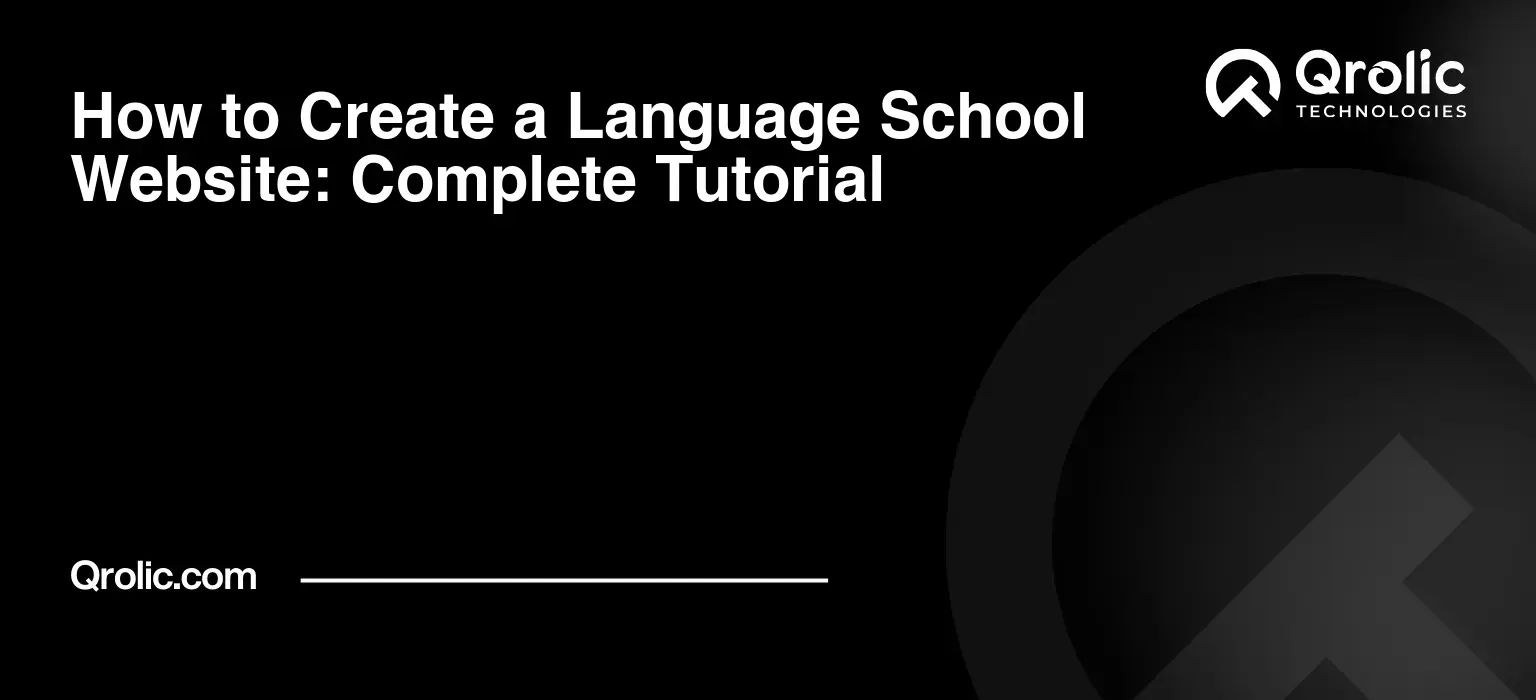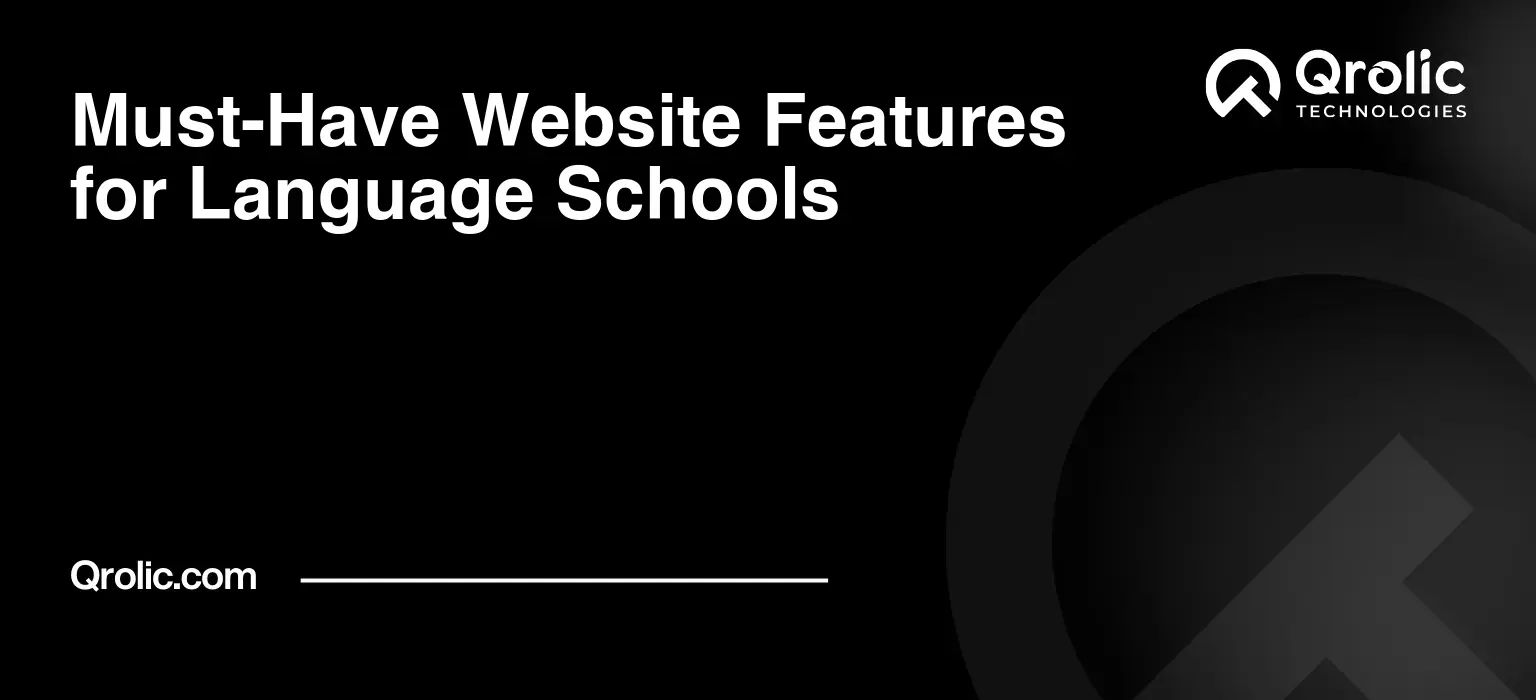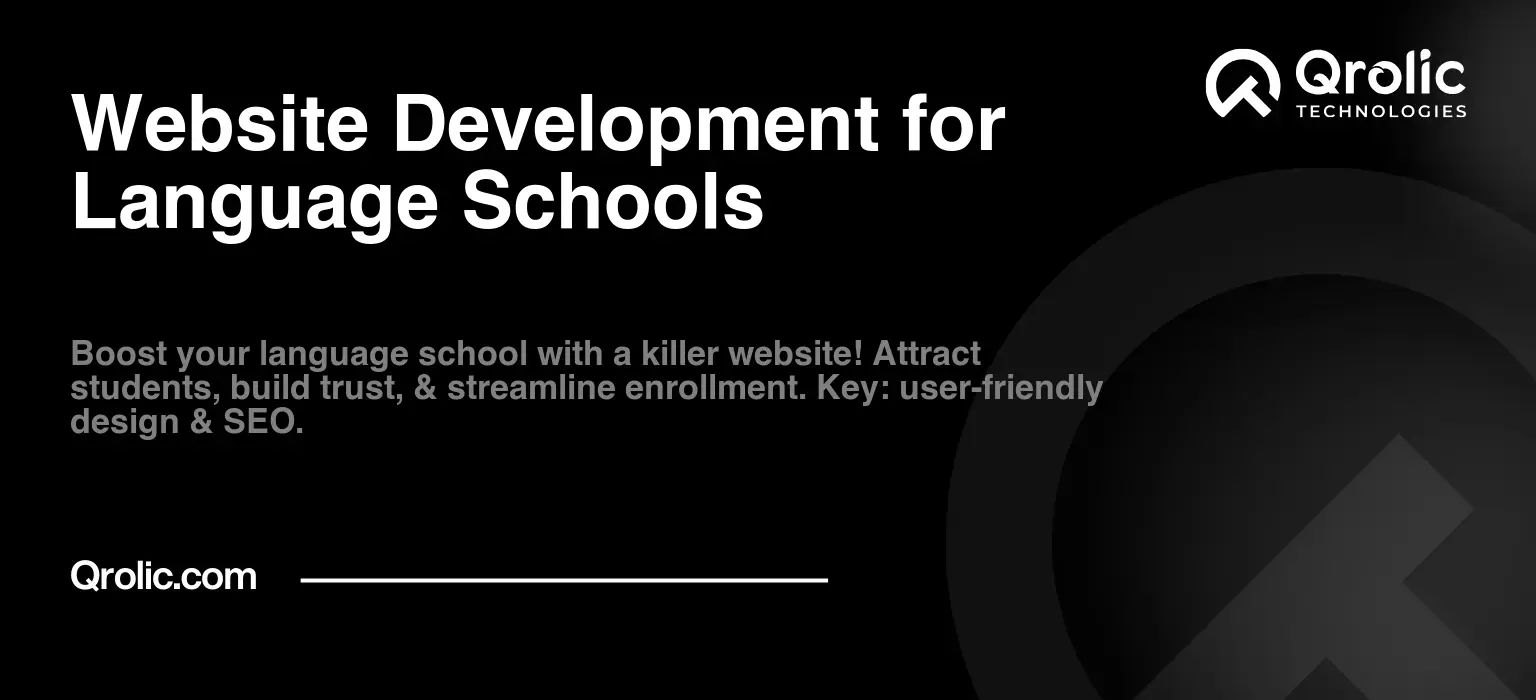
Quick Summary:
- Plan your site with a clear audience and goals.
- Build a user-friendly website with great content and design.
- Market your school using SEO, content, and social media.
- Continuously analyze and improve your website performance.
Table of Contents
- 1 Understanding the “Why” Behind Your Language School Website
- 1.1 Defining Your Target Audience: Who Are You Trying to Reach?
- 1.2 Identifying Your Unique Selling Proposition (USP): What Makes You Different?
- 1.3 Setting Clear Goals and Objectives: What Do You Want to Achieve?
- 2 Planning Your Language School Website: Structure and Content is the key
- 2.1 Site Architecture: Creating a User-Friendly Navigation
- 2.2 Essential Pages for a Language School Website:
- 2.3 Content Strategy: Crafting Compelling and Engaging Content:
- 2.4 Call to Action (CTA): Guiding Visitors Towards Conversion
- 3 Choosing the Right Platform and Tools
- 3.1 Website Builders: Drag-and-Drop Simplicity
- 3.2 Content Management Systems (CMS): Power and Flexibility
- 3.3 WordPress: The Champion of Choice
- 3.4 Essential Plugins for a Language School Website (WordPress):
- 3.5 Domain Name and Hosting: Establishing Your Online Presence
- 4 Designing Your Language School Website: Visual Appeal and User Experience
- 4.1 Choosing a Theme or Template: Setting the Visual Tone
- 4.2 Branding and Visual Identity: Creating a Cohesive Look and Feel
- 4.3 User Experience (UX): Designing for Usability and Engagement
- 4.4 Optimizing Website Speed and Performance: Keeping Visitors Engaged
- 5 Marketing Your Language School Website: Driving Traffic and Generating Leads
- 5.1 Search Engine Optimization (SEO): Getting Found on Google
- 5.2 Content Marketing: Attracting and Engaging Your Audience
- 5.3 Social Media Marketing: Building a Community and Promoting Your School
- 5.4 Email Marketing: Nurturing Leads and Driving Conversions
- 5.5 Paid Advertising (PPC): Driving Targeted Traffic to Your Website
- 6 Analyzing and Improving Your Website: Continuous Optimization
- 6.1 Website Analytics: Tracking Key Metrics
- 6.2 A/B Testing: Experimenting with Different Versions
- 6.3 User Feedback: Gathering Insights from Your Audience
- 6.4 Staying Up-to-Date: Keeping Your Website Fresh
- Qrolic Technologies: Your Partner in Digital Success
- Conclusion: Your Journey to a Successful Language School Website
1 Understanding the “Why” Behind Your Language School Website
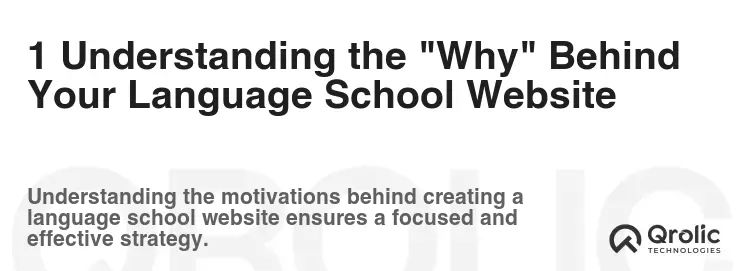
Before diving headfirst into code or dragging and dropping elements, let’s pause and understand the soul of your language school website. It’s not just a digital brochure; it’s your 24/7 brand ambassador, the first point of contact for potential students, and a powerful tool for growth. It needs to resonate with your target audience, instill trust, and effectively communicate the unique value proposition of your language school.
1.1 Defining Your Target Audience: Who Are You Trying to Reach?
-
Why this matters: Understanding your audience is paramount. Are you targeting young professionals seeking business fluency? High school students preparing for international exams? Or perhaps retirees eager to learn a new language for travel? Each group has distinct needs, motivations, and online behaviors.
-
How to define your audience: Conduct market research. Analyze your existing student base (if applicable). Consider factors like age, location, education level, language learning goals, tech-savviness, and preferred communication channels.
-
Example: Imagine you’re targeting young professionals. Your website should emphasize career benefits, practical skills, and flexible learning options. Visuals should feature diverse, aspirational individuals in professional settings. Testimonials should highlight career advancement stories.
1.2 Identifying Your Unique Selling Proposition (USP): What Makes You Different?
-
Why this matters: In a competitive landscape, standing out is crucial. What does your language school offer that others don’t? This could be a unique teaching methodology, specialized courses, experienced instructors, a vibrant community, or a prime location.
-
How to identify your USP: Analyze your strengths. Conduct a competitor analysis to identify gaps in the market. Consider what students consistently praise about your school.
-
Example: Your USP might be “Immersive Language Learning through Cultural Immersion Experiences.” This goes beyond traditional classroom instruction, promising a deeper, more engaging learning experience.
1.3 Setting Clear Goals and Objectives: What Do You Want to Achieve?
-
Why this matters: A website without goals is like a ship without a rudder. Define specific, measurable, achievable, relevant, and time-bound (SMART) goals.
How to set SMART goals:
- Increase Enrollment: “Increase online enrollment by 20% in the next quarter.”
- Generate Leads: “Generate 50 qualified leads per month through contact forms.”
- Improve Brand Awareness: “Increase Website Traffic by 30% within six months.”
- Enhance Customer Satisfaction: “Achieve a customer satisfaction score of 4.5 out of 5 based on website feedback.”
2 Planning Your Language School Website: Structure and Content is the key

With a clear understanding of your audience, USP, and goals, it’s time to map out your website’s structure and content. This blueprint will guide the development process and ensure a user-friendly and effective online experience. Keywords: language school website, planning, website structure
2.1 Site Architecture: Creating a User-Friendly Navigation
-
Why this matters: A well-structured website is easy to navigate, keeping visitors engaged and encouraging them to explore further. A confusing or cluttered site will quickly drive potential students away.
How to plan your site architecture:
- Keep it Simple: Aim for a clear and intuitive navigation menu with no more than 5-7 primary categories.
- Prioritize Key Pages: Place your most important pages (e.g., courses, about us, contact) prominently in the navigation.
- Use a Logical Hierarchy: Organize content into a hierarchical structure with clear parent and child pages.
- Implement Breadcrumbs: Breadcrumbs provide a clear trail for users to navigate back to previous pages.
- Mobile-First Approach: Design your website with mobile users in mind, as a significant portion of your traffic will likely come from mobile devices.
Example Site Map:
- Homepage
- About Us
- Our Mission
- Our Team
- Testimonials
- Courses
- [Language 1]
- Beginner Level
- Intermediate Level
- Advanced Level
- [Language 2]
- Beginner Level
- Intermediate Level
- Advanced Level
- Specialized Courses (e.g., Business English, Exam Preparation)
- [Language 1]
- Resources
- Blog
- Language Learning Tips
- Free Downloads
- Pricing
- Contact Us
- Location
- Online Contact Form
- FAQ
- Schedule a Call
2.2 Essential Pages for a Language School Website:
- Homepage: The virtual front door of your school. It should immediately grab attention, communicate your USP, and guide visitors to key information. Include compelling visuals, clear calls to action (CTAs), and a concise overview of your offerings.
- About Us: Tell your story. Share your school’s mission, values, and history. Introduce your team and highlight their expertise. Build trust by showcasing your personality and passion for language learning.
- Courses: Showcase your language courses in detail. Include course descriptions, learning objectives, schedules, pricing, and instructor bios. Use high-quality images and videos to bring your courses to life.
- Pricing: Be transparent about your pricing structure. Clearly outline the costs associated with each course or program. Offer flexible payment options and consider offering discounts or promotions.
- Resources: Provide valuable resources to attract and engage potential students. This could include blog articles, language learning tips, free downloads, quizzes, and vocabulary lists.
- Contact Us: Make it easy for visitors to get in touch with you. Include a contact form, email address, phone number, and physical address (if applicable). Embed a map to your location.
- Blog: This page will allow you to post blog posts which are related to your business, these posts will help your audience to learn something new, this strategy is called content marketing.
2.3 Content Strategy: Crafting Compelling and Engaging Content:
- Why this matters: Content is king. High-quality, engaging content is essential for attracting visitors, building trust, and converting them into students.
- How to create effective content:
- Write for Your Audience: Use language that resonates with your target audience. Avoid jargon and technical terms.
- Focus on Benefits: Highlight the benefits of learning a language at your school. What can students achieve? How will it improve their lives?
- Tell Stories: Use storytelling to connect with your audience on an emotional level. Share student success stories and testimonials.
- Use Visuals: Incorporate high-quality images, videos, and infographics to break up text and make your content more engaging.
- Optimize for SEO: Research relevant keywords and incorporate them naturally into your content. Use headings, subheadings, and bullet points to improve readability.
- Maintain a Consistent Tone and Style: Establish a consistent brand voice and style across all your website content.
2.4 Call to Action (CTA): Guiding Visitors Towards Conversion
- Why this matters: CTAs are essential for guiding visitors towards your desired outcomes, such as signing up for a course, requesting a brochure, or contacting your school.
- How to create effective CTAs:
- Use Action-Oriented Language: Start your CTAs with strong verbs, such as “Enroll Now,” “Get Started,” “Learn More,” or “Contact Us.”
- Create a Sense of Urgency: Use words like “Limited Time Offer” or “Register Today” to encourage immediate action.
- Make Them Visually Appealing: Use contrasting colors and prominent placement to make your CTAs stand out.
- Test and Optimize: Experiment with different CTAs to see which ones perform best.
3 Choosing the Right Platform and Tools
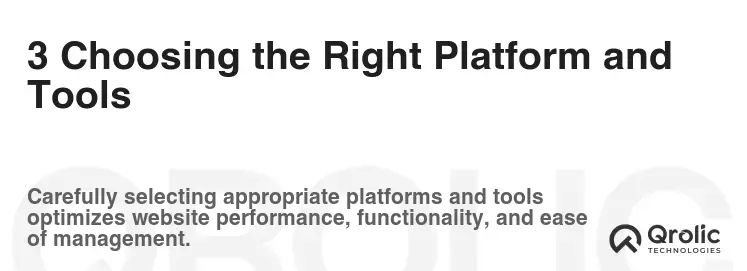
Selecting the right platform and tools is crucial for building a functional, visually appealing, and easily manageable language school website. Several options are available, each with its own strengths and weaknesses.
3.1 Website Builders: Drag-and-Drop Simplicity
-
What they are: Website builders like Wix, Squarespace, and Weebly offer user-friendly drag-and-drop interfaces that allow you to create a website without coding knowledge.
Pros:
- Ease of Use: Simple and intuitive interface.
- Affordable: Often offer budget-friendly plans.
- Templates: Provide a wide range of pre-designed templates.
- All-in-One Solution: Handle hosting, security, and updates.
Cons:
- Limited Customization: Less flexibility compared to other options.
- SEO Limitations: Can have limitations in terms of SEO optimization.
- Vendor Lock-in: Difficult to migrate your website to another platform.
- Features: Often have limited feature set.
-
Best for: Small language schools with limited budgets and technical expertise.
3.2 Content Management Systems (CMS): Power and Flexibility
-
What they are: CMS platforms like WordPress, Joomla, and Drupal offer more flexibility and control over your website.
Pros:
- Highly Customizable: Extensive customization options through themes and plugins.
- SEO Friendly: Excellent SEO capabilities.
- Scalable: Can handle large amounts of content and traffic.
- Large Community: Access to a large community of developers and support resources.
Cons:
- Steeper Learning Curve: Requires more technical knowledge than website builders.
- Maintenance: Requires ongoing maintenance and security updates.
- Cost: Can be more expensive due to hosting, themes, and plugins.
-
Best for: Language schools that require a high degree of customization, scalability, and SEO optimization.
3.3 WordPress: The Champion of Choice
- Why WordPress is Often Recommended: WordPress is the most popular CMS in the world, powering over 40% of all websites. Its open-source nature, extensive plugin library, and active community make it a versatile and powerful platform for creating a language school website.
- Wide Range of Themes and Plugins: Thousands of themes and plugins available to customize your website’s appearance and functionality.
- SEO Friendly: Excellent SEO capabilities with plugins like Yoast SEO and Rank Math.
- Scalable: Can handle large amounts of content and traffic.
- Easy to Use: Relatively easy to learn and use, especially with page builder plugins like Elementor and Beaver Builder.
3.4 Essential Plugins for a Language School Website (WordPress):
- Elementor or Beaver Builder: Page builder plugins for creating custom layouts without coding.
- Yoast SEO or Rank Math: SEO plugins for optimizing your website for search engines.
- Contact Form 7 or Gravity Forms: Contact form plugins for collecting leads.
- LearnDash or LifterLMS: Learning management system (LMS) plugins for creating and selling online courses.
- WPML or Polylang: Translation plugins for creating a multilingual website.
- WP Rocket or LiteSpeed Cache: Caching plugins for improving website speed and performance.
3.5 Domain Name and Hosting: Establishing Your Online Presence
- Domain Name: Your website’s address on the internet (e.g., yourlanguageschool.com). Choose a domain name that is easy to remember, relevant to your school, and reflects your brand.
- Hosting: The server where your website files are stored. Choose a reliable hosting provider with good uptime, security, and customer support.
- Considerations:
- Domain Name Extensions: .com is the most common and recognizable extension, but consider other extensions like .org, .net, or country-specific extensions like .ca or .uk.
- Hosting Types: Shared hosting is the most affordable option, but it can be slower and less reliable. VPS hosting and dedicated hosting offer more resources and control but are more expensive.
- SSL Certificate: An SSL certificate is essential for securing your website and protecting user data. It’s indicated by the padlock icon in the browser’s address bar. Keywords: content management systems, WordPress Plugins, website hosting
4 Designing Your Language School Website: Visual Appeal and User Experience

A visually appealing and user-friendly website is essential for attracting and retaining visitors. Your website’s design should reflect your brand identity, create a positive user experience, and guide visitors towards your desired outcomes.
4.1 Choosing a Theme or Template: Setting the Visual Tone
- Why this matters: Your website’s theme or template sets the overall visual tone and layout. Choose a theme that is professional, modern, and relevant to the language school industry.
- Considerations:
- Responsiveness: Ensure your theme is responsive, meaning it adapts to different screen sizes and devices.
- Customization Options: Choose a theme that offers sufficient customization options to match your brand.
- SEO Friendliness: Select a theme that is optimized for search engines.
- Speed and Performance: Choose a lightweight theme that loads quickly.
- Tips:
- Browse Theme Marketplaces: Explore theme marketplaces like ThemeForest and TemplateMonster for a wide selection of themes.
- Use Demo Content: Import demo content to get a head start on building your website.
- Customize the Theme: Don’t be afraid to customize the theme to match your brand identity.
4.2 Branding and Visual Identity: Creating a Cohesive Look and Feel
- Why this matters: Your brand identity is how your language school is perceived by the world. It includes your logo, colors, fonts, and overall visual style.
- Elements of a Strong Brand Identity:
- Logo: A memorable and recognizable logo that represents your school.
- Color Palette: A consistent color palette that reflects your brand’s personality.
- Typography: A consistent font selection that is easy to read and reflects your brand’s style.
- Imagery: High-quality images and videos that are relevant to your school and target audience.
- Tips:
- Create a Style Guide: Develop a style guide that outlines your brand’s visual elements and ensures consistency across all your marketing materials.
- Use High-Quality Images: Invest in professional photography or use high-quality stock photos.
- Maintain a Consistent Tone: Use a consistent tone of voice across all your website content.
4.3 User Experience (UX): Designing for Usability and Engagement
- Why this matters: User experience is how visitors feel when they interact with your website. A positive user experience is essential for keeping visitors engaged, encouraging them to explore further, and converting them into students.
- Key Principles of Good UX:
- Intuitive Navigation: Make it easy for visitors to find what they’re looking for.
- Clear and Concise Content: Use clear and concise language that is easy to understand.
- Mobile-First Design: Design your website with mobile users in mind.
- Fast Loading Speed: Optimize your website for speed and performance.
- Accessibility: Ensure your website is accessible to users with disabilities.
- Tips:
- Conduct User Testing: Get feedback from real users to identify areas for improvement.
- Use Heatmaps and Analytics: Use tools like Hotjar and Google Analytics to track user behavior and identify areas where visitors are dropping off.
- Optimize for Mobile: Ensure your website is fully responsive and optimized for mobile devices.
4.4 Optimizing Website Speed and Performance: Keeping Visitors Engaged
- Why this matters: Website speed is a critical factor in user experience and SEO. slow-loading websites can frustrate visitors and negatively impact your search engine rankings.
- Factors Affecting Website Speed:
- Image Size: Large image files can significantly slow down your website.
- Code Bloat: Excessive or poorly written code can also slow down your website.
- Caching: Caching stores frequently accessed data to improve loading times.
- Hosting: Your hosting provider can also impact your website’s speed and performance.
- Tips for Optimizing Website Speed:
- Optimize Images: Compress images without sacrificing quality using tools like TinyPNG or ImageOptim.
- Minify Code: Minify HTML, CSS, and JavaScript files to reduce their size.
- Enable Caching: Use a caching plugin like WP Rocket or LiteSpeed Cache.
- Choose a Fast Hosting Provider: Select a hosting provider with good uptime and performance.
- Use a Content Delivery Network (CDN): A CDN distributes your website’s content across multiple servers to improve loading times for users around the world. Keywords: education design, website user experience, visual identity
5 Marketing Your Language School Website: Driving Traffic and Generating Leads

Building a great website is only half the battle. You need to actively market your website to attract visitors, generate leads, and convert them into students.
5.1 Search Engine Optimization (SEO): Getting Found on Google
- Why this matters: SEO is the process of optimizing your website to rank higher in search engine results pages (SERPs). Higher rankings can drive significant organic traffic to your website.
- Key SEO Strategies:
- Keyword Research: Identify relevant keywords that your target audience is searching for.
- On-Page Optimization: Optimize your website’s content, title tags, meta descriptions, and headings for your target keywords.
- Off-Page Optimization: Build high-quality backlinks from other reputable websites.
- Technical SEO: Ensure your website is technically sound and easy for search engines to crawl and index.
- Tools:
- Google Keyword Planner: Research keywords and estimate search volume.
- Google Search Console: Monitor your website’s performance in Google search.
- Yoast SEO or Rank Math: Optimize your website’s content for search engines.
- Ahrefs or SEMrush: Analyze your competitors and track your keyword rankings.
5.2 Content Marketing: Attracting and Engaging Your Audience
- Why this matters: Content marketing is the process of creating and distributing valuable, relevant, and consistent content to attract and engage your target audience.
- Content Marketing Strategies:
- Blog Posts: Write informative and engaging blog posts on topics related to language learning, culture, and travel.
- Ebooks and Whitepapers: Create in-depth guides and reports on specific language learning topics.
- Infographics: Visually appealing infographics that present data and information in an easy-to-understand format.
- Videos: Create engaging videos on topics related to language learning, culture, and your school.
- Social Media: Share your content on social media platforms to reach a wider audience.
- Tips:
- Create a Content Calendar: Plan your content in advance to ensure a consistent flow of high-quality content.
- Promote Your Content: Share your content on social media, email, and other marketing channels.
- Track Your Results: Monitor your content’s performance and adjust your strategy as needed.
5.3 Social Media Marketing: Building a Community and Promoting Your School
- Why this matters: Social media marketing is the process of using social media platforms to build a community, promote your school, and generate leads.
- Social Media Strategies:
- Choose the Right Platforms: Focus on the platforms where your target audience is most active.
- Share Engaging Content: Share a mix of content, including blog posts, images, videos, and quizzes.
- Run Contests and Giveaways: Run contests and giveaways to generate excitement and engagement.
- Engage with Your Audience: Respond to comments and messages promptly and engage in conversations.
- Use Paid Advertising: Use paid advertising to reach a wider audience and target specific demographics.
- Platforms:
- Facebook: A popular platform for connecting with a wide range of users.
- Instagram: A visual platform for sharing images and videos.
- Twitter: A platform for sharing short updates and engaging in conversations.
- LinkedIn: A professional platform for connecting with businesses and professionals.
- YouTube: A platform for sharing videos.
5.4 Email Marketing: Nurturing Leads and Driving Conversions
- Why this matters: Email marketing is the process of using email to nurture leads, promote your school, and drive conversions.
- Email Marketing Strategies:
- Build an Email List: Collect email addresses from your website visitors using opt-in forms.
- Segment Your List: Segment your list based on demographics, interests, and behavior.
- Send Targeted Emails: Send targeted emails to each segment of your list.
- Automate Your Emails: Use email automation to send welcome emails, follow-up emails, and promotional emails automatically.
- Tools:
- Mailchimp: A popular email marketing platform with a free plan for small businesses.
- ConvertKit: A powerful email marketing platform for creators.
- ActiveCampaign: A marketing automation platform with email marketing capabilities.
5.5 Paid Advertising (PPC): Driving Targeted Traffic to Your Website
- Why this matters: Paid advertising is a fast and effective way to drive targeted traffic to your website.
- PPC Platforms:
- Google Ads: The most popular PPC platform, allowing you to target users based on keywords, demographics, and location.
- Social Media Ads: Platforms like Facebook, Instagram, and LinkedIn offer advertising options to reach specific demographics and interests.
- PPC Strategies:
- Keyword Research: Identify relevant keywords to target.
- Ad Copy: Write compelling ad copy that highlights the benefits of your school.
- Landing Pages: Create dedicated landing pages for your ads.
- Bid Management: Manage your bids effectively to maximize your return on investment.
- Tracking and Optimization: Track your results and optimize your campaigns as needed. Keywords: Complete Tutorial, website marketing, lead generation
6 Analyzing and Improving Your Website: Continuous Optimization
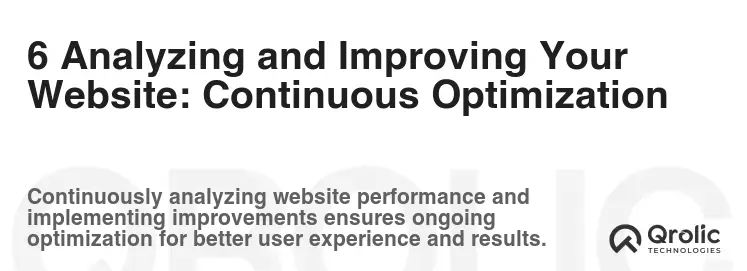
Creating and launching your language school website is not the end of the process; it’s just the beginning. You need to continuously analyze your website’s performance, identify areas for improvement, and make adjustments to optimize your results.
6.1 Website Analytics: Tracking Key Metrics
- Why this matters: Website analytics provide valuable insights into how visitors are interacting with your website. By tracking key metrics, you can identify areas where your website is performing well and areas where it needs improvement.
- Key Metrics to Track:
- Traffic: The number of visitors to your website.
- Bounce Rate: The percentage of visitors who leave your website after viewing only one page.
- Time on Site: The average amount of time visitors spend on your website.
- Conversion Rate: The percentage of visitors who complete a desired action, such as signing up for a course or contacting your school.
- Top Pages: The most popular pages on your website.
- Traffic Sources: The sources of traffic to your website (e.g., organic search, social media, email).
- Tools:
- Google Analytics: A free and powerful website analytics platform.
- Google Search Console: Monitor your website’s performance in Google search.
- Hotjar: A tool for tracking user behavior, including heatmaps, recordings, and feedback polls.
6.2 A/B Testing: Experimenting with Different Versions
- Why this matters: A/B testing is the process of comparing two versions of a webpage or element to see which one performs better. By A/B testing different elements, you can optimize your website for conversions.
- Elements to A/B Test:
- Headlines: Test different headlines to see which ones attract more attention.
- Call to Actions: Test different CTAs to see which ones generate more clicks.
- Images: Test different images to see which ones resonate better with your audience.
- Layouts: Test different layouts to see which ones improve user experience.
- Tools:
- Google Optimize: A free A/B testing tool from Google.
- Optimizely: A popular A/B testing platform with advanced features.
- VWO: A comprehensive A/B testing and website optimization platform.
6.3 User Feedback: Gathering Insights from Your Audience
- Why this matters: User feedback provides valuable insights into how your audience perceives your website. By gathering feedback from your audience, you can identify areas where your website is falling short and make improvements to better meet their needs.
- Methods for Gathering User Feedback:
- Surveys: Create online surveys to gather feedback on specific aspects of your website.
- Feedback Forms: Include a feedback form on your website to allow visitors to submit their comments and suggestions.
- User Testing: Conduct user testing sessions to observe how real users interact with your website.
- Social Media: Monitor social media channels for mentions of your school and website.
- Tips:
- Ask Specific Questions: Ask specific questions to get actionable feedback.
- Make it Easy to Provide Feedback: Make it easy for visitors to provide feedback by using clear and concise forms.
- Respond to Feedback: Respond to feedback promptly and acknowledge any issues that are raised.
6.4 Staying Up-to-Date: Keeping Your Website Fresh
- Why this matters: The online landscape is constantly evolving. To stay competitive, you need to keep your website fresh and up-to-date with the latest trends and technologies.
- Strategies for Staying Up-to-Date:
- Regularly Update Your Content: Add new content and update existing content to keep your website fresh and relevant.
- Keep Your Software Up-to-Date: Keep your CMS, plugins, and themes up-to-date to ensure security and performance.
- Monitor Industry Trends: Stay informed about the latest trends in the language school industry and online marketing.
- Attend Conferences and Workshops: Attend conferences and workshops to learn from industry experts and network with other professionals. Keywords: analyzing website data, improving website performance, search engine optimization
Qrolic Technologies: Your Partner in Digital Success

At Qrolic Technologies (https://qrolic.com/), we understand the unique challenges and opportunities faced by language schools in the digital age. We offer a comprehensive suite of digital marketing services designed to help you attract more students, build your brand, and achieve your business goals.
Our Services:
- Website Design and Development: We create visually stunning and user-friendly websites that are optimized for conversions.
- Search Engine Optimization (SEO): We help you rank higher in search engine results pages (SERPs) to drive organic traffic to your website.
- Content Marketing: We create engaging and informative content that attracts and engages your target audience.
- Social Media Marketing: We help you build a strong social media presence and connect with potential students.
- Pay-Per-Click (PPC) Advertising: We manage your PPC campaigns to drive targeted traffic to your website.
- Email Marketing: We help you nurture leads and drive conversions through email marketing.
Why Choose Qrolic Technologies?
- Experience: We have years of experience working with language schools and other education providers.
- Results-Driven: We are focused on delivering measurable results for our clients.
- Customized Solutions: We tailor our services to meet your specific needs and goals.
- Transparent Communication: We provide regular updates and communicate openly with our clients.
- Dedicated Team: You’ll have a dedicated team of experts working on your project.
Let us help you take your language school to the next level. Contact us today for a free consultation.
Conclusion: Your Journey to a Successful Language School Website

Creating a successful language school website is a journey, not a destination. It requires careful planning, execution, and continuous optimization. By following the steps outlined in this complete tutorial, you can create a website that attracts more students, builds your brand, and helps you achieve your business goals. Remember to stay focused on your target audience, highlight your unique selling proposition, and continuously analyze and improve your website to stay ahead of the competition. Good luck!
